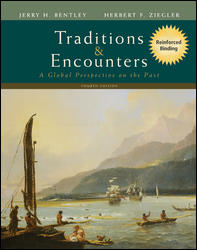Traditions and Encounters, 4th Edition (Bentley)Chapter 3:
EARLY AFRICAN SOCIETIES AND THE BANTU MIGRATIONSOverviewCultivation and domestication of animals transformed African cultures, like cultures in southwest Asia, into distinctive societies with more formal states, specialized labor, and more elaborate cultural traditions. The region around the Nile River, Egypt to the north and Nubia to the south supported the fastest growing and most complex societies in Africa. These societies were noted for their: - Centralized political authority embodied in the absolute ruler the pharaoh in Egypt and the person of the King in the region of Kush (Nubia)
- Imperialist expansion in the second millennium B.C.E. as the Egyptian army pushed into Palestine, Syria, and north Africa and south into Nubia and as the Kushites later conquered Egypt and expanded their influence to the south
- Highly stratified and patriarchal societies based on an agricultural economy
- Development of industries, transportation, and trade networks that facilitated economic growth and the intermingling of cultural traditions
- Writing systems: hieroglyphic, hieratic, demotic, and Coptic scripts in Egypt and the yet-to-be-translated Meroitic inscriptions in Nubia
- Organized religious traditions that include worship of Amon and Re, sun gods, the cult of Osiris, pyramid building, and in Egypt, mummification of the dead
- At the same time that Egypt and Nubia were becoming increasingly complex societies, the Bantu-speaking peoples to the south were undertaking gradual migrations from their homeland in west central Africa and displacing or intermingling with the foraging peoples of the forests. These migrations, and others, helped to spread both agricultural technology and, after 1000 B.C.E., iron metallurgy throughout sub-Saharan Africa.
 | 
















